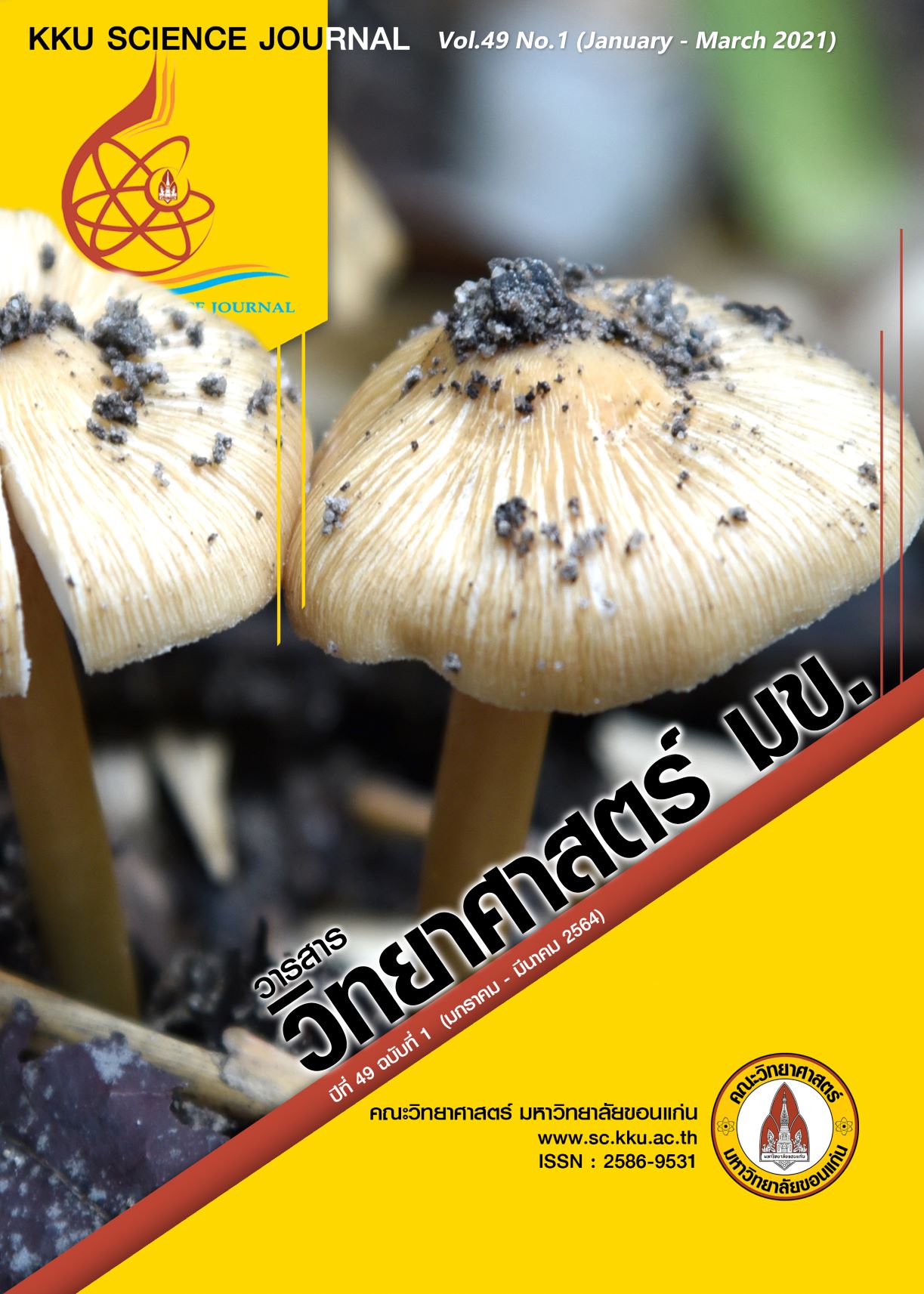Effects of Light-Emitting Diodes on Seed Germination and the Accumulation of Phenolic Content in Sprouts
Main Article Content
Abstract
Light–emitting diodes (LEDs) are a new type of energy-saving light source with the potential to revolutionize horticultural lighting technology for crop production. They can induce the germination and synthesis of bioactive compounds, which may improve the nutritional values and antioxidant properties of sprouts. This study aimed to investigate the combination of red (630 nm) and blue light (470 nm) from LEDs, with different light intensities on seed germination and accumulation of antioxidants in sprouts. Rice, mungbean, sunflower and sesame seeds were germinated under a combination of red and blue LED lights (7:3) at three light intensities (420, 200 and 145 µmol/m2/s) using dark condition as control. The results revealed that germinated rice and sunflower seeds cultivated under the combination of red and blue LEDs at a light intensity of 145 µmol/m2/s showed the highest α–amylase activity and total phenolic content. In addition, a high germination percentage of these crops was found at light intensities of 200 and 145 µmol/m2/s. Therefore, the combination of LED light at an intensity of 145–200 µmol/m2/s could be used to improve the α–amylase activity and germination of seeds and total phenolic content in sprouts.
Article Details

This work is licensed under a Creative Commons Attribution-NonCommercial-NoDerivatives 4.0 International License.
References
Ajdanian, L., Babaei, M. and Aroiee, H. (2019). The growth and development of cress (Lepidium sativum)affected by blue and red light. Heliyon 5(7): 1–9.
Akbarian, B., Matloobi, M. and Mahna, N. (2016). Effects of LED Light on Seed Emergence and Seedling Quality of Four Bedding Flowers. Journal of Ornamental Plants 6(2): 115–123.
Bewley, J. D., Bradford, K., Hilhorst, H. and Nonogaki, H. (2013). Seeds: Physiology of development, germination and dormancy. 3rd Edition. New York: Springer-Verlag.
Boonyakiat, D. (2011). Plant Physiology [On-line], Available: www.cssckmutt.in.th/cssc/cssc_classroom/...Doc/10_Plant%20and%20Solar.pdf.
Butsabasri, T. (2012). World Population [On-line], Available: https://www.gotoknow.org/posts/418083
Darko, E., Heydarizadeh, P., Schoefs, B., and Sabzalian, M. R. (2014). Photosynthesis under artificial light: the shift in primary and secondary metabolism. Philosophical Transactions of the Royal Society B: Biological Sciences. 369(1640): 1–7.
Johkan, M., Shoji, K., Goto, F., Hashida, S. and Yoshihara, T. (2010). Blue Light-emitting Diode Light Irradiation of Seedlings Improves Seedling Quality and Growth after Transplanting in Red Leaf Lettuce. HortScience 45(12): 1809–1814.
Kato-Noguchi, H. and Macías, F. A. (2005). Effects of 6-methoxy-2-benzoxazolinone on the germination and α-amylase activity in lettuce seeds. Journal of Plant Physiology 162(12): 1304-1307.
Lal, N. and Sachan, P. (2017). Effect of different Visible Light wavelengths on Seed Germination and Photosynthetic Pigment Contents in Vigna unguiculata (L.) Walp. Indian Jounal of Biology 4(2): 132–136.
Lobiuc, A., Vasilache, V., Pintilie, O., Stoleru, T., Burducea, M., Oroian, M. and Zamfirache, M. M. (2017). Blue and Red LED Illumination Improves Growth and Bioactive Compounds Contents in Acyanic and Cyanic Ocimum basilicum L. Microgreens.Molecules 22(2111): 1-14.
Nie, N. H., Hull, C. H. and Bent, D. H. (1970). SPSS: Statistical package for the social sciences. United stated: McGraw-Hill.
Ohashi-Kaneko, K., Matsuda, R., Goto, E., Fujiwara, K. and Kurata, K. (2006). Growth of rice plants under red light with or without supplemental blue light.Soil Science and Plant Nutrition. 52(4): 444–452.
Patel, E. K., Chandawat D. K. and Patel, Y. M. (2017). Effect of light on seed germination of Vigna radiata. European Journal of Pharmaceutical and Medical Research 4(12): 444–448.
Ryu, J. H., Seo, K. S., Choi, G. L., Rha, E. S., Lee, S. C., Choi, S. K., Kang, S. Y. and Bae, C. H. (2012). Effects of LED Light Illumination on Germination, Growth and Anthocyanin Content of Dandelion (Taraxacum officinale). Korean Journal of Plant Resources 25(6): 731–738.
Samuolienė, G., Urbonavičiūtė, A., Brazaitytė, A., Šabajevienė, G., Sakalauskaitė, J. and Duchovskis, P. (2011). The impact of LED illumination on antioxidant properties of sprouted seeds. Central European Journal of Biology. 6(1): 68–74.
Taiz, L. and Zeiger, E. (2010). Plant Physiology. 5th Edition. Sunderland, Massachusetts U.S.A.: Sinauer Associates Inc.
Vaštakaitė, V., Viršilė, A., Brazaitytė, A., Samuolienė, G., Jankauskienė, J., Sirtautas, R., Novičkovas, A., Dabašinskas, L., Sakalauskienė, S., Miliauskienė, J. and Duchovskis, P. (2015). The Effect of Blue Light Dosage on Growth and Antioxidant Properties of Microgreens. Scientific works of the institute of horticulture, lithuanian research centre for agriculture and forestry and aleksandras stulginskis university. Sodininkystė ir daržininkystė 34(1–2): 25-35.
Zhao, M., Zhang, H., Yan, H., Qiu, L. and Baskin, C. C. (2018). Mobilization and Role of Starch, Protein, and Fat Reserves during Seed Germination of Six Wild Grassland Species. Frontiers in Plant Science. 9(234): 1-11.


